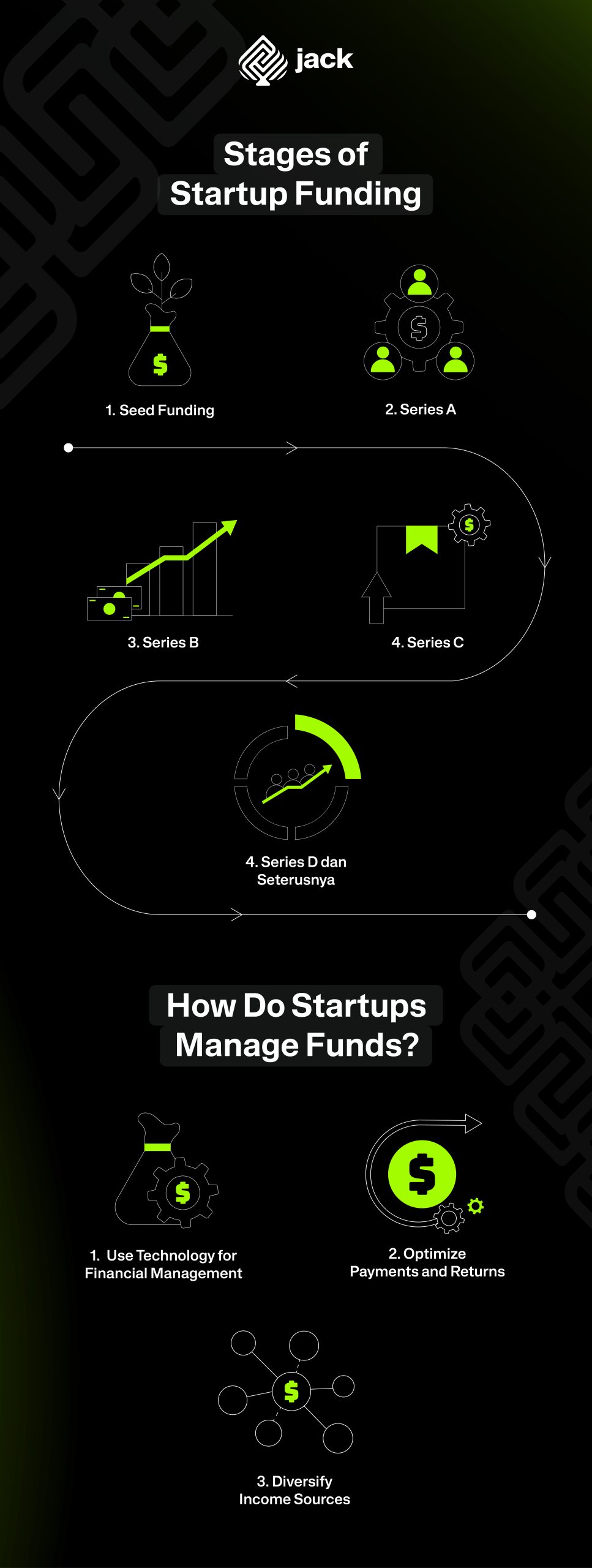For most startup companies, securing sufficient funding is a critical step towards achieving long-term growth and success. This process is often referred to as startup funding or startup financing.
Without adequate funding, a startup may struggle to enter a market already dominated by established competitors, pursue growth, or survive long-term competition.
Therefore, startup financing typically comes from various sources, ranging from personal funding, family or colleagues, angel investors, venture capital, to crowdfunding. The abundance of funding streams is why the mechanism for startup funding is carried out in various stages.
How Do Startups Get Funding?

Startup businesses are usually associated with innovative ideas. Therefore, they need strong funding for recruiting highly qualified workers, product development, and expanding the market.
For example, an entrepreneur wants to establish a startup for a fruit and vegetable shopping platform based on an app. Since the food products are entirely taken from suppliers, the only product that needs to be developed from scratch is the application for the platform itself.
So, the startup founder needs to recruit many employees for the development of the application prototype. Although it’s just a prototype, the development funds are not small because it involves several IT experts to build a strong and secure app infrastructure from cybercrime.
Therefore, the founder decides to look for investors. Before reaching a funding agreement, investors certainly need to be convinced that they will get a return on their investment. That’s why almost all deals with angel investors, venture capital, and private equity companies involve share ownership.
In this way, investors will get their money back when the company starts making a profit. Of course, accompanied by profit sharing according to the previous agreement.
Companies looking for funding from outside usually start with the initial round or seed round. After that, some will continue to Series A, B, and C rounds.
But before the funding round begins, investors will ask for clarity about the valuation or value of the company. This assessment is important because it affects investor interest and how much capital is willing to be disbursed.
Usually, the company’s valuation is measured by considering several things:
- Business plan maturity
- Company management
- Market size
- Track record
- Business risks
After the assessment is complete, the startup can start the funding round.
Once Funding is Secured, Where is it Allocated?
There are several cases where funding from abroad for Indonesian startups has to stop first in Singapore. The Minister of Investment/Head of the Investment Coordinating Board (BKPM), Bahlil Lahadalia, quoted by merdeka.com on 9/6/23, said one of the reasons was because the financial center in the country was not yet adequate.
Summarized from Tech in Asia, there are several obstacles for foreign investors to fund local startups, one of which is high taxes. Indonesia imposes a capital gain tax of up to 25%.
In comparison, Singapore and Malaysia do not have any capital gain tax at all. Countries like Singapore are therefore considered a solution because they provide tax relief and various grants and loans for startup companies.

Stages of Startup Funding
Because startup funding involves obtaining capital from various sources, it is important for entrepreneurs to understand the various stages that will be passed. Quoted from Indeed, here are some stages of startups in seeking funding support:
1. Seed funding
Quoted from Alpha JWC Ventures, about 29 percent of startups fail after running out of capital when bootstrapping. To sustain in the long term, startups need to seek external funding.
At that time, the business enters the seed funding phase. But before officially entering that stage, there will usually be a preparation stage called pre-seed funding.
In the pre-seed stage, the business starts the research phase. Most startups are indeedin the product development phase during pre-seed. These are the questions that founders need to answer:
Is the business idea viable, in the sense that it is realistic to last in the long term and can profit from year to year?
- Has there been the same idea before?
- How expensive is it to build a business?
- What is the business model like?
- How will the business start?
To more accurately target consumers, startups then proceed to market research on a much larger scale. At this point, the business enters the seed funding round. Seed funding can come from family, friends, angel investors, or venture capital. However, the amount varies greatly, between $10,000 and $2 million.
- This capital helps startups finance various initial steps such as:
- Conducting product research
- Launching products
- Marketing products to target consumers
- Building an audience
2. Series A
After startups use funds from seed funding to develop products and build a customer base, businesses start looking for Series A funding. Just like the previous stage, Series A funding is also preceded by a pre-series stage.
Pre-Series A is often used to validate business concepts and as proof that the product has a strong market potential. From there, investors will be convinced that the company is capable of achieving mature growth.
Continuing then to the next stage, namely Series A. Companies at this stage often attract investors from private equity firms, with an average generating funding of $2 million to $15 million.
- This funding can help companies to:
- Expand product offerings
- Reach more customers
- Develop long-term plans for growth
3. Series B
Before entering Series B funding, the company will go through the pre-Series B phase. At this stage, the business has been able to prove the potential of the product for a wider market.
Next in Series B funding, startups focus on seeking funding to develop products. Investors help startups achieve this by expanding the market reach. Quoted from Hubspot, Series B funding averaged $50 million in 2022, up from $35 million in 2020.
The funds collected in this round are often used to:
- Recruit new employees
- Boost sales
- Marketing
- Technology development
- Customer service
4. Series C
This round can be reached by successful startups that then need extra funds to grow and survive. But before getting a funding injection from investors, the company also prepares in the pre-series phase. In this phase, investors want to see if startups can show significant business growth and a strong customer base.
After that, the company officially enters the Series C funding round where investors want a more aggressive market expansion. Because the capital is intended for the business scale to grow as quickly as possible, the nominal can reach $88 million to $89.5 million.
- The funds can be used for:
- Creating new products
- Acquiring other companies
- Expansion to new markets
- Recruiting experienced management teams
- Increasing funding before IPO
5. Series D and beyond
Only a few companies go up to the Series D funding stage and beyond. Companies at this funding stage must already have an established customer base, revenue stream, positive growth track record, and a solid plan in using funds from investors.
Spend with Flexibility, Anywhere with Jack
How Do Startups Manage Funds?
In addition to understanding the mechanism of startup funding, it is also important for entrepreneurs to have the ability to manage the funds that have been obtained. What are effective fund management strategies?
1. Use technology for financial management
The world of startups, which is now closely associated with the adoption of modern technology, uses the concept of open banking as one of the ways to manage finances. What is open banking?
In short, the open banking system gives bank account holders control over their data and shares it with third parties. Communication between third parties (usuallyfintech) and banks is facilitated by a technology called API or Application Interface Programming, a centralized platform that connects various services from different apps or software.
By using APIs, fintech allows clients to streamline the process of managing finances. For example, a fintech platform allows a startup to combine separate accounts in large numbers and view all transaction data from a centralized platform.
If you have a short runway (the time you have before running out of capital) and a high burn rate (a lot of money being used), then open banking can provide many benefits. One of them is transparency of cash flow.
2. Optimize payments and returns
To manage funds effectively, optimize payment and receipt policies. Some things that can be done, such as monitoring and timely billing to buyers, negotiating terms with suppliers, and reducing delays and uncollectible receivables.
3. Diversify income sources
Startups can consider diversifying income sources. The reason is, that startups that want to expand the market, of course, they need to reduce dependence on just one product. By exploring other potential markets, it can help businesses reduce cash flow volatility.
Funding is fundamental for all companies, not excluding startups. The large number of startups that want to chase growth in the early stages of establishment certainly makes the funding process a main focus.
Use Jack for your business needs
After startup funding begins to be achieved with its various stages, companies need effective financial management so as not to waste capital. Therefore, many startups are starting to adopt technology for the integration of all their financial activities, ranging from payments to and from customers to payroll management.






